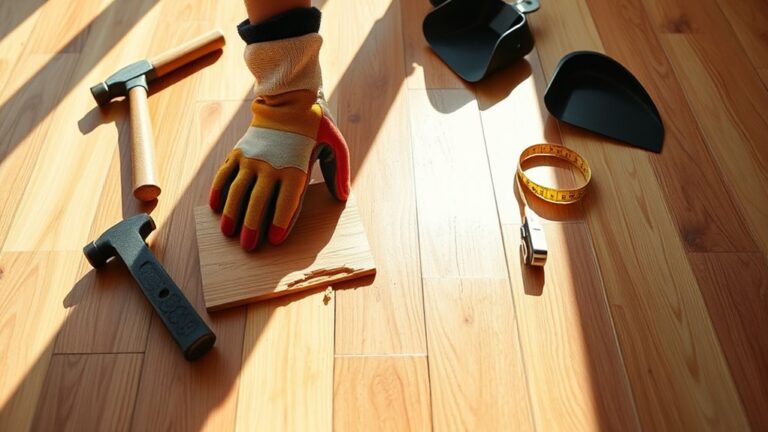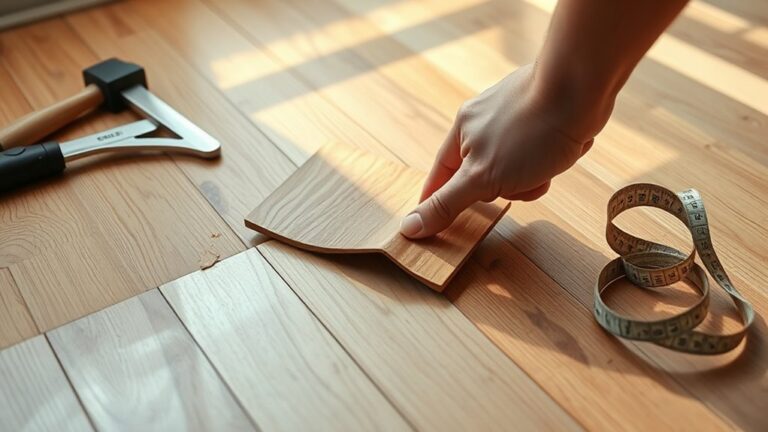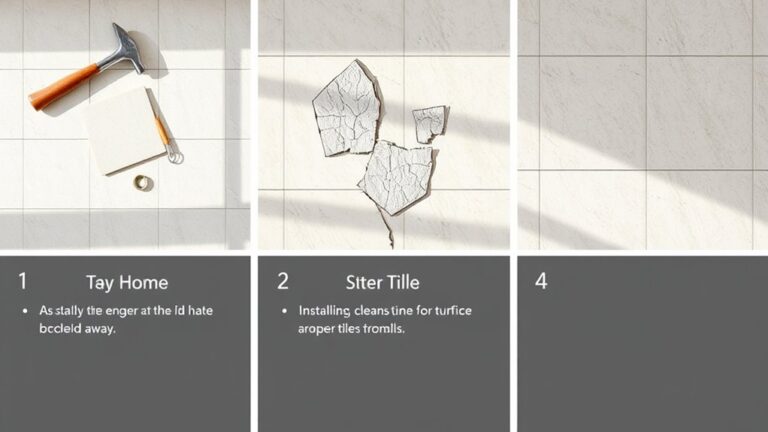For effective soundproofing during floor installations, focus on selecting appropriate materials and techniques. Start with dense rubber or felt underlays, which greatly reduce impact noise. Incorporate Mass Loaded Vinyl (MLV) to block both airborne and impact sounds. Ascertain to decouple flooring layers to minimize sound transmission, and utilize acoustic caulk in expansion gaps to prevent moisture and noise leakage. Regularly inspect your flooring for wear and address any gaps or cracks that may permit sound transfer. Proper installation and material choices can create a quieter living space, and you'll discover even more strategies for achieving ideal soundproofing results.
Understanding Noise Types
When it comes to tackling sound issues in your home, understanding the different types of noise is vital. Two primary categories of noise you'll encounter are impact noise and airborne noise. Impact noise is generated by physical collisions, such as footsteps or furniture movement. This type of noise primarily transmits through floors, making effective soundproofing essential in multi-level buildings. If you're living in an upper unit, you might notice how sound travels more easily through lighter flooring materials, leading to greater noise transmission.
On the other hand, airborne noise includes sounds that travel through the air, like conversations or television sounds. Unlike impact noise, airborne noise often requires different soundproofing solutions because it can disturb adjacent spaces without physical contact. To achieve ideal noise reduction, you'll need to address both types of noise simultaneously.
Effective soundproofing must consider the unique characteristics of each noise type. For instance, untreated floors can allow significant disturbances from impact noise while also permitting airborne noise to permeate nearby units. To combat these issues, it's important to select appropriate soundproofing materials tailored to your specific needs. Heavy, mass-rich materials like concrete can be more effective against noise transmission compared to lighter alternatives.
Importance of Soundproofing
Recognizing the importance of soundproofing is essential, especially in multi-story living environments where noise can easily travel between floors. Effective soundproofing techniques are vital for enhancing your comfort and privacy, as they considerably reduce noise transmission and impact sound from everyday activities.
Consider the following benefits of soundproofing your floors:
- Dramatic noise reduction: Enjoy a peaceful home with noise levels reduced by up to 30 decibels.
- Enhanced acoustic quality: Create an environment that's perfect for listening to music or watching television without distractions.
- Improved neighbor relations: Keep your upstairs and downstairs neighbors happy by minimizing footstep and furniture movement noise.
- Increased property value: Homes with effective sound insulation are more appealing to potential buyers.
- Personal tranquility: Experience a sanctuary where you can relax, free from intrusive sounds.
Utilizing soundproof flooring and materials like mass loaded vinyl and acoustic flooring underlays can greatly improve sound insulation. Proper installation is key to achieving maximum noise reduction and preventing sound leakage between rooms. By investing in soundproofing, you're not just blocking unwanted noise; you're also creating a more pleasant living space. The benefits extend beyond mere comfort; they contribute to a lifestyle where you can fully enjoy your home without the constant intrusion of noise. Embrace the freedom that comes with a quieter environment, and make soundproofing a priority in your floor installations.
Selecting Soundproofing Materials
Selecting the right soundproofing materials is essential for achieving ideal noise reduction in your living space. By choosing the appropriate options, you can effectively minimize sound transmission between floors, ensuring a quieter environment. One highly effective material is mass loaded vinyl, which is designed specifically to block sound. Its heavy composition makes it a solid choice for various flooring installations.
When considering soundproofing methods, don't overlook acoustic flooring underlays. Dense rubber options provide a cushioning effect that considerably reduces impact noise, minimizing vibrations that can travel through flooring layers. For enhanced performance, consider Iso-Step® soundproofing underlayment. This product can improve your Impact Insulation Class (IIC) ratings, making it suitable for different flooring types and improving overall soundproofing capabilities.
If you're installing engineered wood or laminate floors, felt underlayment is an excellent choice. Its density offers superior noise reduction compared to foam alternatives, effectively dampening sound across your flooring surface. For those opting for ceramic or stone floors, using PROFLEX 90 MSC Flooring Underlayment can be beneficial. Not only does it assist in soundproofing, but it also prevents cracking and maintains even floor levels.
Techniques for Effective Soundproofing
After choosing the right soundproofing materials, implementing effective techniques is key to maximizing their benefits. To successfully soundproof a floor, consider the following techniques:
- Use acoustic flooring underlays made from dense materials like rubber to greatly reduce impact noise and airborne sound transmission.
- Employ decoupling techniques to create a gap between your flooring and the subfloor, disrupting vibrations and minimizing sound transfer.
- Introduce mass loaded vinyl as an additional layer within the floor assembly; its high density is effective in blocking sound transmission.
- Incorporate insulation materials in the cavities between floors to absorb sound, which helps reduce reverberation and enhances overall acoustic quality.
- Prioritize proper installation techniques, including acclimatizing materials and guaranteeing a clean, level subfloor to guarantee maximum effectiveness.
Addressing Existing Floors
When addressing existing floors, start by evaluating their current condition to identify areas needing soundproofing. Effective underlayment options, such as acoustic materials, can greatly enhance noise reduction, while retrofitting solutions like Mass Loaded Vinyl (MLV) provide additional density to block sound transmission. Ensuring complete coverage during installation is essential for maximizing the effectiveness of your soundproofing efforts.
Assessing Current Floor Conditions
Before diving into soundproofing solutions, it's crucial to assess the current floor conditions thoroughly. This step lays the groundwork for effective soundproofing and guarantees that you address any underlying issues contributing to noise. Start by evaluating the existing flooring and the materials involved, as different types will have unique sound insulation properties.
Here are key aspects to reflect on:
- Check for gaps, cracks, or loose boards that allow sound transmission.
- Inspect the subfloor's structure and accessibility for potential soundproofing layers.
- Look for signs of damage or wear that could worsen noise issues, like squeaks.
- Conduct a preliminary sound test by walking on the floor to detect noticeable impact noise.
- Document areas where sound absorption seems insufficient.
Effective Underlayment Options
Selecting the right underlayment is essential for enhancing soundproofing in existing floors. One top choice is Impact Barrier® Flooring Underlayment, which effectively reduces impact vibrations and improves noise control without needing to remove your current flooring. If you're working with engineered wood or laminate, felt underlayment made from dense materials offers effective sound reduction, helping to absorb sound waves.
For those considering ceramic or stone tile installations, cement boards provide high-density sound-blocking capabilities that can greatly enhance your flooring solution. Another excellent option is acoustic foam underlayment, specifically designed to absorb noise. It can be easily placed directly on the subfloor before installing new flooring.
If you're looking for a lightweight and easy-to-install solution, polyethylene foam is a great choice. It not only creates a smooth surface but also effectively reduces impact noise transmission. By incorporating these soundproofing underlayment options, you can dramatically improve the acoustic comfort of your space, allowing you to enjoy the benefits of your flooring while minimizing disruptions from noise.
Retrofitting Soundproofing Solutions
Retrofitting soundproofing solutions for existing floors doesn't have to involve extensive renovations or removal of your current flooring. You can effectively enhance your space's acoustics with a few strategic additions.
Consider the following options:
- Mass-loaded vinyl: Layer it over existing flooring to block both airborne and impact noise.
- Thick carpet padding: Install this under carpets to absorb impact noise, improving sound quality without major changes.
- Acoustic ceiling tiles: Position these below upper floors to mitigate noise bleed from foot traffic, creating a peaceful living environment.
- Soundproofing compounds: Use products like Green Glue between layers of flooring to dampen vibrations and reduce impact noise.
- FloorFighter: This product can be installed directly above your current surface to effectively reduce sound transmission.
These retrofitting methods allow you to maintain the aesthetics of your existing flooring while considerably improving soundproofing. By implementing these solutions, you'll foster a more serene and comfortable atmosphere in your home, free from disruptive noises. Embrace the freedom of a quieter living space with these innovative techniques.
Soundproofing New Installations
When soundproofing new installations, you'll want to assess the accessibility of your subfloor to guarantee effective treatment. Choosing the right underlayment can greatly impact noise reduction, so consider high-density options for ideal performance. Additionally, following proper installation techniques is essential for achieving the best soundproofing results in your new flooring project.
Assessing Subfloor Accessibility
Evaluating subfloor accessibility is a critical step in soundproofing new installations, as it directly influences the methods you can employ. When determining subfloor accessibility, consider the following factors to determine the best soundproofing methods:
- Ease of access: Can you reach the subfloor without extensive demolition?
- Condition of the subfloor: Are there any structural issues that need addressing?
- Type of flooring layer: What materials are currently in place?
- Potential for vibration transfer: How does sound travel through your existing structure?
- Height limitations: Is there enough vertical space to install soundproofing materials effectively?
If the subfloor is accessible, you can apply soundproofing materials like dense underlayment or mass loaded vinyl directly, greatly enhancing noise reduction before installing the final flooring layer. However, if access is limited, you might need to pivot to structural isolation techniques, such as decoupling the flooring from the subfloor, to minimize vibration transfer. Properly evaluating subfloor accessibility guarantees you choose effective soundproofing methods that contribute to a quieter living environment. Taking these steps will ultimately lead to a more serene space, granting you the freedom to enjoy your home without unnecessary disturbances.
Choosing Effective Underlayment
Once you've assessed subfloor accessibility, the next step is to select an effective underlayment for your new installation. The right underlayment is vital for soundproofing, greatly reducing both impact noise and airborne sound transmission between floors. Options like dense rubber or felt underlays are excellent choices, enhancing acoustic comfort for residential and commercial spaces.
Ensure that the underlayment you choose is compatible with your flooring type. For instance, laminate or engineered wood flooring benefits from specific underlayments that improve sound insulation and moisture resistance. Products like Impact Barrier® Flooring Underlayment are specifically designed to boost Impact Insulation Class (IIC) ratings, ensuring considerable noise reduction during the installation process.
Proper installation of the underlayment is essential. Lay it flat and seamless to avoid gaps that could allow sound to travel through the floor assembly, undermining your soundproofing efforts. By carefully selecting and installing the right underlayment, you can create a quieter, more comfortable environment that enhances your living or working space. Prioritize these elements to achieve effective soundproofing for your new flooring installation.
Installation Techniques for Success
To achieve ideal soundproofing during your flooring installation, employing the right techniques is crucial. Proper installation of soundproofing floors can greatly reduce noise levels, guaranteeing a quieter environment. Here are key techniques to take into account:
- Acclimatize your floor underlayment and flooring materials for at least 48 hours for peak performance.
- Use a floating floor system for laminate or engineered wood, laying Iso-Step® underlayment with a perimeter isolation strip to minimize sound transmission.
- For nail-down hardwood flooring, apply the raft method by loose laying Iso-Step® underlayment from wall to wall, effectively absorbing sound and reducing vibration.
- Before tile installation, install a perimeter isolation strip, using approved adhesive and a flooring roller to ascertain proper adhesion.
- Incorporate acoustical caulk in expansion gaps to minimize noise transmission and protect against moisture-related damage.
When these techniques are installed correctly, they create a robust sound control system. Using quality insulation material and following these steps will help you attain a serene living space, free from disruptive impacts. Embrace the freedom of enjoying your home without the disturbances of unwanted noise.
Maintenance and Best Practices
Effective maintenance of soundproofing materials is vital for guaranteeing long-lasting noise reduction in your home. Regular inspections of the soundproofing materials beneath your flooring, such as underlayment and insulation, are essential. By checking these components, you can confirm they remain intact and effective in reducing noise.
Proper maintenance of flooring surfaces plays an important role in prolonging the lifespan of soundproofing materials. Keep your floors clean and avoid excess moisture, as this can cause degradation that may lead to increased noise transmission. If you're considering replacing or updating your flooring, don't overlook the opportunity to reapply soundproofing techniques and materials. This can greatly enhance sound insulation in your new installation.
In high-traffic areas, using area rugs or carpets with dense padding can help absorb impact noise and maintain the effectiveness of your existing soundproofing measures. It's also important to verify that any furniture or décor you place on the floor doesn't obstruct or compress your soundproofing materials. Compression can diminish their noise-blocking capabilities, undermining your efforts for a quieter home.
Frequently Asked Questions
How to Make Your Floors Soundproof?
To make your floors soundproof, start by using acoustic underlayment beneath your flooring for effective noise reduction. Consider soundproof mats or sound-absorbing rugs to dampen vibrations. Installing floor insulation can act as a noise barrier, while resilient channels help decouple sound transmission. Additionally, applying damping compounds or soundproofing panels can enhance soundproofing. Combining these techniques will create a quieter environment, allowing you to enjoy your space without the intrusion of unwanted noise.
How Do You Soundproof Between Floors After Construction?
Imagine your home as a harmonious orchestra, where each sound is a note played perfectly. To soundproof between floors after construction, you'll want to use acoustic underlayment and soundproof mats to reduce floor vibration. Consider adding resilient channels and ceiling insulation for better sound isolation. Don't forget carpet padding and soundproofing compounds to further enhance your efforts. By focusing on floor joist isolation, you can achieve a peaceful sanctuary from unwanted noise.
How to Stop Sound From Coming Through the Floor?
To stop sound from coming through the floor, you'll want to use acoustic underlayment as a foundational layer for effective noise isolation. Consider combining flooring materials with vibration damping techniques, like resilient channels, to create sound barriers. Additionally, implementing sound absorption methods, such as thick carpet padding, can greatly reduce impact noise. This combination will enhance your space's overall acoustics, providing a quieter and more peaceful environment.
What Is the Cheapest Way to Soundproof a Floor?
Imagine a tranquil oasis amidst chaos—your home. To achieve this, consider the cheapest way to soundproof your floor. You can use acoustic mats or carpet tiles for impact absorption. A rubber underlayment beneath your flooring is a solid DIY solution. Mass-loaded vinyl adds density, while foam panels enhance isolation. Don't forget floor cushions to soften sound, or even soundproof paint for walls. Each element brings you closer to that serene escape.




